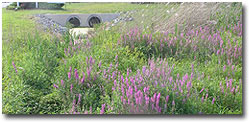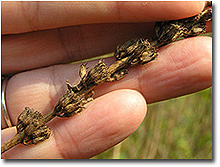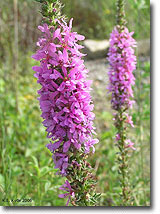Purple Loosestrife
(Lythrum salicaria)
Purple loosestrife is an aggressive plant that produces millions of seeds and takes over wetlands.
Life History:

Although purple loosestrife is herbaceous, its square, slightly hairy
stems can become woody and persist for more than 1 year. It grows back
each spring from the roots, producing multiple stems from the same
rootstock, so that mature plants resemble bushy shrubs. Purple loosestrife produces clusters of bright pinkish-purple flowers on wands
at the top of the plant. Flowers usually have 6 petals, are about 1”
wide, and are pollinated by insects. Purple loosestrife is generally not
self-compatible.
Followi

ng fertilization, seeds are produced. Purple loosestrife seeds
are minute and are borne in ¼” long capsules, which open at the top. A
single mature plant may produce over 2.5 million seeds! Purple loosestrife seeds are light enough to be dispersed by wind. They float,
so they can be moved in water. They may also hitch a ride on waterfowl
and other animals feeding in marshes with loosestrife present, or on
people’s clothing, feet or gear, including vehicles. Purple loosestrife
seeds remain viable in the seed bank, even when they are wet, for over 2
years.
Identification:

Purple loosestrife is an erect, perennial herb, with a candelabrum of
flowering branches at the top of the plant. It can grow anywhere from 4
to 8 feet tall. It has opposite leaves that are long and narrow with
pointed tips, smooth edges, and heart-shaped bases that connect directly
to the plant stem with no leaf stalks.
Habitat & Range:
Purple loosestrife grows primarily in freshwater wetlands,
floodplains, along stream banks or lake edges, ponds or other shallow
wet areas, in forested swamps where it gets enough light, and in
roadside or field ditches and canals. Purple loosestrife grows well in
full sun; in shaded conditions it may be smaller in stature or have
fewer blossoms.
Purple loosestrife is native to many places around the world,
including northern Africa, parts of Russia, parts of the Middle East,
China, Japan, and most of Europe. Purple loosestrife is now present in
every U.S. state except Louisiana, Florida. South Carolina, and Hawaii.
Invasion:
Purple loosestrife has been introduced multiple times into North
America, originally inadvertently in ships' ballast in the early 1800s
and thereafter for horticultural, economic, or medicinal purposes. The
plant was present as seed and propagules in the sand and shale that was
used to give weight and stability to trans-Atlantic sailing vessels. It
spread from ballast fields near harbors where ballast was dumped in New
York. As the New England and mid-Atlantic canal systems were built, and
settlers cleared forests, drained wetlands, and disturbed soil, purple loosestrife spread inland. Seeds also came in caught in raw wool or on
livestock shipped from Europe. Purple loosestrife was well established
by the 1860s. Herbarium and garden records from the 1880s and 1890s show
that it was widely planted, including horticultural varieties.
Invasion Impact:
Purple loosestrife affects natural areas by changing wetland physical
structure, plant species composition, and even water chemistry. Purple loosestrife can spread within marsh systems to create monotypic stands.
Such a shift in the density and number of species present in a marsh
presents challenges to the animal species living in that marsh.
Waterfowl food plants decrease in availability. Nesting sites decline
and nests become more vulnerable because purple loosestrife provides
greater cover for nest predators such as foxes. Virginia rails and
American and least bitterns all avoid nesting in purple loosestrife.
Furthermore, purple loosestrife can alter habitat for the federally
listed bog turtle. Where purple loosestrife dominates, the invasive
plant can decrease food resources available for bog turtles.

While not a threat to most terrestrial crop systems, purple loosestrife has affected the production of wild hay and wild rice,
primarily in mid-Western prairie pothole wetlands. In the mid-Atlantic,
livestock forage quality and quantity declines in purple loosestrife
infested pastures. The plant’s dense and spreading root system can clog
irrigation ditches, impede boat traffic, and reduce wetland recreational
use.
Management:
Purple loosestrife seems to have relatively little direct economic
cost. However, the cost of controlling it in natural wetlands and
navigable waters soars into the millions. Thirty-three states classify purple loosestrife as a noxious weed or require a permit for it. While
states differ in their approaches, in most cases, noxious weeds are
required to be controlled.

The most promising approach to purple loosestrife control is biological control, using leaf and stem-feeding beetle species
Galerucella calmariensis and
G. pusilla.
Identified and thoroughly tested for host range specificity by
scientists at Cornell University, these European beetles received
approval for release in the U.S. in 1995.
Galerucella feeds on
flower buds, leaves and stem tissue of purple loosestrife, and
completely defoliates the plant, causing large reductions in the biomass
of purple loosestrife.
Acknowledgements
All photos (except American bittern and bog turtle) by Kerrie Kyde
Contact
Jonathan McKnight
Associate Director, Habitat Conservation
Wildlife & Heritage Service
Maryland Dept. of Natural Resources
580 Taylor Ave., E-1
Annapolis, MD 21401
(410) 260-8539
Toll-free in Maryland:
1-877-620-8DNR, Ext. 8539
E-Mail: jonathan.mcknight@maryland.gov